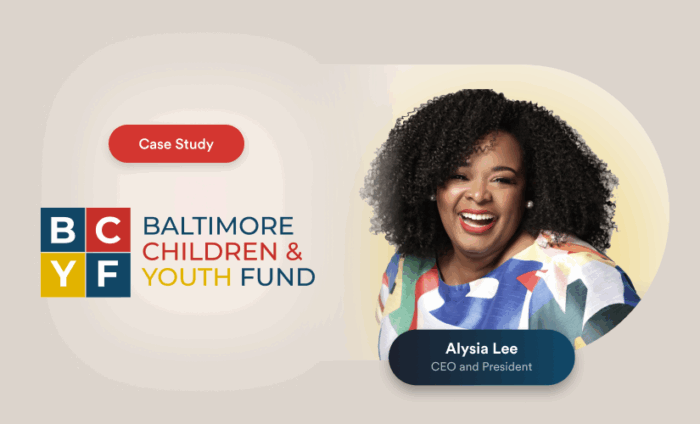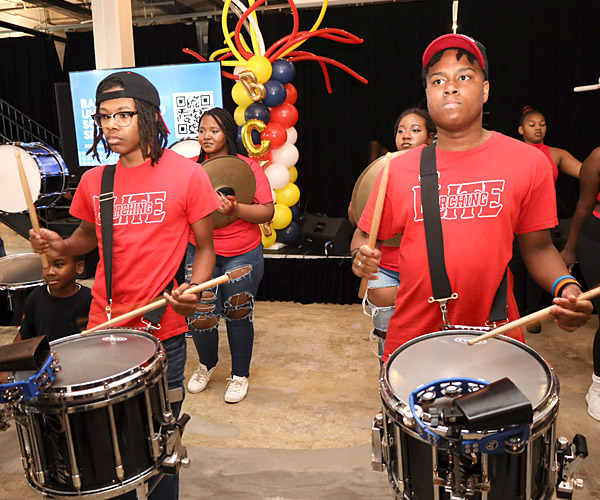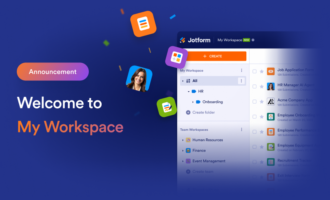
BCYF case study results at a glance
326
# of forms
17
# of Jotform Enterprise Teams
$9 million
Grant funds awarded in 2024
A youth baseball league. A nonprofit public laboratory where kids can conduct science experiments. A mentorship program to help young women of color pursue aviation careers. These are just a handful of the 100-plus youth-focused organizations supported by the Baltimore Children & Youth Fund (BCYF) last year alone.
Created in 2016, BCYF aims to address inequality in the city of Baltimore, Maryland, by providing grants and capacity-building support to grassroots organizations that serve children and teens. Since 2021, it has awarded $31 million in grants. Uniquely, it is entirely funded by the city’s residents (through a portion of property taxes) to ensure that “children and youth are healthy, ready to succeed in school, and live in stable, safe, and supportive families and communities.”
The fund receives roughly 100 applications for grants each year, which go through a complex process of reviews and approvals. It also provides hands-on support for applicants throughout the application process. And because the organization is publicly funded, all its activities must be transparent and traceable.
To manage all of this without getting bogged down in bureaucracy and manual workflows, staff needed a software tool that was easy to use, flexible, and could be customized to address a variety of needs. They opted for Jotform Enterprise.
Why Jotform Enterprise
Previously, the BCYF team used Google Forms to conduct surveys, collect feedback, and gather information on how organizations use awarded funds. But, says president and CEO Alysia Lee, “we just needed to [switch] from Google Forms to something more elevated. And [Jotform Enterprise] really gives us space to still be creative about multiple ways we can use it to guide our processes.
Every minute that a grantee is tied up in a bureaucratic process is a minute that a young person is not getting access to high-quality youth programs that these dollars can support and sustain.
Alysia Lee, CEO and President, Baltimore Children and Youth Fund
“We [were] looking for something where…anytime we’re asking questions or compiling information or guiding a process, we could use the same tool, and it was the only tool that met all of the needs across the organization,” says Lee.
Keith Spraker, BCYF’s director of information technology, says that they also needed a way to reduce the amount of time spent on repetitive, manual tasks. “We were using a lot of spreadsheets, a lot of manual methods with limited workflows,” says Spraker. “I think what drove us toward Jotform was the workflows: being able to have an approval workflow go through in a form.”
Saving time (and sanity) with automated processes
Using Jotform Workflows, the team has been able to automate approval processes for expense reimbursements, grant applications, permissions slips, and more. As each person signs off on an item, it’s automatically sent to the next stage in the workflow, preventing bottlenecks.
Says Lee, “I was drafting a process document last week and it was like, thank goodness we have Jotform, we don’t have to actually stop and get a signature for each of these things. We just need to develop a workflow in Jotform that will process this document through everyone for review and approval and also keep the process transparent.”
Jotform Workflows provides a record of each step of a process, so the entire team can see the status of an expense or application, as well as who has approved it and when. “So if you don’t know where [a] document is in the process,” says Lee, “you don’t have to track it down.”
The reporting it’s basically just one-click reporting, which is really great especially for our really longer forms. We don’t have to go through crunching all those numbers. You click a button and you’ve got all of your graphs right there.
Derek Basthemer, Grants Process Manager, Baltimore Children and Youth Fund
One of BYCF’s most-used forms in Jotform Enterprise is actually for internal purposes: a payment request form for tracking and processing reimbursements. The team set up a workflow for the form that uses conditional logic to route reimbursement requests to the appropriate approver, based on criteria like which department it belongs to. This automation speeds up the process while providing transparency. It also saves people from having to decide who to forward the expense to next.
Says Lee, “If it was a manual process, someone would have to…look at each transaction and…sort it by OK, what’s the review and approval pathway for this $5.99 receipt?”
As Grants Process Manager Derek Basthemer puts it, “Sanity saved alone is worth it.”
Simplifying reporting
Automating workflows like reimbursement requests also makes it easier to keep clear records that can give the team an overview of the fund’s activities at a glance.
“We are funded primarily by Baltimore City, [so] we need accountability for all of those funds,” says Spraker. “So every dollar we spend, we need to have a paper trail for. We utilize a payment request form for every credit card transaction, every ACH transaction that we do, every invoice we get.”
Basthemer uses Jotform Enterprise to simplify reporting on each year’s grant cycle. Using submissions from a variety of forms, he can build a picture of how well programs performed and how well the grant process works for applicants overall.
“We’ve got community grant reviews, we’ve got pre-application technical assistance, and we’ve got feedback from actual applicants,” he says. “We kind of collate all of that together to get a picture of how the grant year went or the application year went.”
Using Jotform Report Builder, Basthemer can see results at a glance, making it easier to synthesize all the information gathered through forms. “The reporting it’s basically just one-click reporting,” he says, “which is really great especially for our really longer forms. We don’t have to go through crunching all those numbers. You click a button and you’ve got all of your graphs right there, which is really helpful.”
Managing digital assets
For BCYF’s communication team, Jotform Enterprise is a lifesaver when it comes to collecting and managing materials for the fund’s grantees. The department uses Jotform Enterprise to gather assets like logos and photos from organizations to use in BCYF’s communications.
“Speaking from the comm’s environment,” says Brandon Hansen, vice president of external affairs, “if we had to collect everyone’s graphics, their content, or anything like that in any other way, it probably would have been a lot more tedious. So it does…alleviate the time spent across the organization.”
With Jotform, grantees can upload images, videos, and even voice recordings through forms. These assets are then stored centrally for anyone on the communication team to access.
Sharing knowledge and resources
Using the Teams function in Jotform Enterprise, staff can also see how other departments have approached a form or process, so they don’t have to create their own versions from scratch. At the same time, they can also use the permissions settings to make sure forms can only be edited by the appropriate team members.
“I can’t necessarily edit everyone’s form on a team, but I can go to another team’s form to be like, ’How did they do this?’” says Hansen. “And that’s helpful…because then I really just need to go look at their team, look at the form and say, they did it like this. Got it. Great.”
The platform itself can also serve as a way to train people in how to build repeatable processes. By using Jotform Enterprise to create workflows for forms, staff learn what it takes to map out steps and close gaps in processes.
Says Lee, “People who maybe a year ago would have been like, ‘I’m not a process person — I don’t even know how to create steps’ have started to think about things in those ways. And that’s helpful inside Jotform and out.”
Getting funds where they need to go
While lightening the workload for staff is a huge plus, the team says the biggest benefit of using Jotform Enterprise has been speeding up the process of getting funds to organizations that can make a difference in young people’s lives. The faster that staff can conduct essential processes like grant application reviews, the faster organizations can put funds to use.
Says Lee, “Every minute that a grantee is tied up in a bureaucratic process is a minute that a young person is not getting access to high-quality youth programs that these dollars can support and sustain.”
For example, grantees are required to submit monthly financial expense reports. Basthemer created a Jotform workflow to handle appeals for expense reports that missed the submission deadline. “People’s grant dollars are dependent upon this process moving quickly,” says Lee. Having an automated way to manage appeals ensures that the process is efficient and transparent.
“All of the communications are in Jotform, then also the reporting,” says Lee. “So when I ask for a project report of the process they’re able to put that together quickly. It would definitely be at least times five in terms of hours to do it manually.”
Ease of use and flexibility
Just recently, says Lee, BCYF needed to customize an application form for a youth-led advisory board. Instead of just reusing the version of the application for adult board members, they wanted to customize it to better suit the audience.
Again, Jotform Enterprise had the features and flexibility they needed. Not only could they easily change the look and feel of the form, they could add fields and functionality that would be more useful for young people.
“We wanted young people to be able to make a video if they wanted to or record their voices. And so it was like, ‘Great, Jotform does all that.’”








































































































Send Comment: